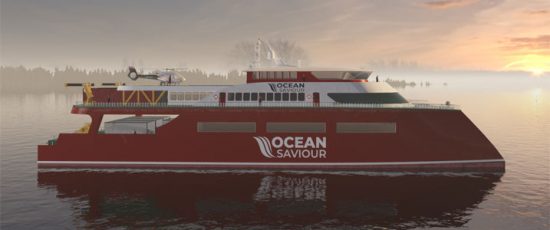Ocean Saviour a self-powering 70m tri-deck clean-up vessel, purposefully engineered is planning to locate, retrieve and recycle an estimated 80,000 tonnes of plastic from the Great Pacific Garbage Patch using what it collects to power itself.
Ocean Saviour is striking, aggressive and contemporary in appearance with the focus being on function and affordability to build, rather than external styling. The design is based on great experience and the pure science of naval architecture.
The designers agreed that all technological advances in alternative energy technologies should be incorporated where possible, but not at the expense of the overall appeal of the design. It is planned for solar power panels and multiple small wind generators to be incorporated into powering ancillary systems.
Central to its design are Manta Collector Array collection systems at the side and front of the vessel which will deploy and draw in plastics. The plastics will then be fed into an on board conveyor, chopped finely, milled and processed through an on board plasma gasification facility which will destroy it completely with minimal atmospheric pollution. The product of this pioneering process will then be used to fuel the vessel, making it self-powering.
This compact waste destruction process was first implemented for marine use on board the USS Gerald R. Ford an Aircraft Carrier, by advanced plasma processing company, PyroGenesis.
The US Navy specified the system for the ship in order to have a highly compact, sailor-friendly means of destroying waste out at sea, as an aircraft carrier can be out for many months without coming to port. The team behind Ocean Saviour is currently investigating several potential partners in relation to the provision of plasma technology.
The design team collaborating with Ocean Saviour have recommended a large-scale catamaran as the most economical and stable option on the water. The open plan lower deck will be one of the main working areas of the vessel and has been specially designed to allow ventilation with hinged storm shutters which offer protection against the weather.
This entire deck is dedicated to plastic removal and industrial scale recycling. Mid-deck is home to two 12m containers which will offer research laboratory facilities or VIP accommodation options and bulk storage area, aft of the crew quarters. While the curved front windows are reflective of a superyacht in its design, the purpose is far more utilitarian as it will lessen the impact of rogue waves, green water and windage and offer maximum visibility for the crew. The wheelhouse is located on the third deck which will also house the main crew areas and helipad.
This pioneering project is the brainchild of Richard W. Roberts and Simon White, founders of TheYachtMarket.com.
Compelled by the need to do something to tackle the extraordinary plight of our oceans, they began throwing around some ideas with some of the world’s top naval architects and yacht designers, in an attempt to look at new ways to bring together existing technologies to tackle the problem.
Just a few short months later, the Ocean Saviour project has begun to take shape and is working in conjunction with several highly regarded organisations and notable figures from across the global marine industry.
Mankind produces approximately 300 million tonnes of plastic each year, five times what we produced 50 years ago, and an estimated 8 million tonnes of this ends up in our oceans every year.
A single Ocean Saviour vessel aims to clear five tonnes of plastic per day, that’s nearly two kilotonnes per year. This would mean that one Ocean Saviour vessel would take 40 years to clean up the Pacific gyre using plasma technology, which can therefore be scaled up if there was more than one vessel in operation.”

